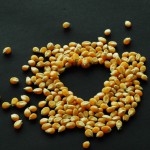Today, Corn Commentary offers a guest post from blogger Sara Ross, a CommonGround Iowa volunteer. Ross, along with 85 volunteers in 15 states, is participating in a movement that looks to open a conversation between the women who grow food and those why purchase it.
CommonGround was formed by the National Corn Growers Association, the United Soybean Board and their state affiliates to provide our nation’s female farmers with opportunities to connect with their urban and suburban counterparts on an issue important to all of them – the food they feed their families.
 It’s Valentine’s Day. It’s a day of love, flowers, presents, candy and high fructose corn syrup….
It’s Valentine’s Day. It’s a day of love, flowers, presents, candy and high fructose corn syrup….
Wait….what???
Yes, high fructose corn syrup will be present on Valentine’s Day in many of your candies and soft drinks. Not to worry though! In this post I’m going to clear up some common myths and misconceptions about this hot topic. Misconception 1: High fructose corn syrup is bad for you.
Answer: High fructose corn syrup has almost the same composition as table sugar, honey and fruit juices like grape and apple. “When high fructose corn syrup and sugar are absorbed into our bloodstream, the two are indistinguishable by the body,” Joan Salge Blake, M.S., R.D., L.D.N. Sugar is sugar and all of it should be consumed in moderation.
Misconception 2: High fructose corn syrup is not natural.
Answer: This is not true. HFCS is made from corn, a naturally occurring food. It contains no artificial or synthetic ingredients or color additives. It also meets the U.S. Food and Drug Administration’s requirements for use of the term “natural.”
Misconception 3: High fructose corn syrup is causing wide-spread obesity in the United States.
Answer: In 2008 the American Medical Association (AMA) concluded that HFCS does not appear to contribute more to obesity than any other caloric sweeteners. “At this time there is insufficient evidence to restrict the use of high fructose syrup or label products that contain it with a warning,” said AMA Board Member William Dolan, MD. “We do recommend consumers limit the amount of all added caloric sweeteners to no more than 32 grams of sugar daily based on a 2,000 calorie diet in accordance with the Dietary Guidelines for Americans.”
“The real issue is not high fructose corn syrup. It’s that we’ve forgotten what a real serving size is. We have to eat less of everything,”stated David Klurfeld, Ph.D, from the Agricultural Research Service at the USDA.
Misconception 4: High fructose corn syrup is used only as a sweetener in food and beverages.
Answer: HFCS is a popular ingredient for many manufacturers. Here are some of the ways it is used:
- As a liquid, it is easily incorporated into beverages and also stays in solution better— making a higher quality product.
- As a form of invert sugar, fructose combines with protein in the presence of heat to give browning—toasted bread is an example. Because it has a higher amount of fructose, HFCS provides better browning in baked products.
- Using HFCS instead of granular sugar helps lock in moisture in baked products. This extends shelf life by keeping the baked product fresher for a longer time period. This same moistness also gives cookies and snack bars a softer texture.
- Because it is a syrup (rather than granules), the fructose and glucose molecules do not form undesired crystals in candies and ice cream—giving those foods a smoother mouth feel and a more desirable product.
- HFCS contributes thickness, or viscosity, to condiments and salad dressings.
When doing some research on candy companies and what their stances are about HFCS, I found thatThe Hershey Company says this, “The Hershey Company uses a variety of sweeteners to deliver products with well-known tastes and textures while maintaining our high quality standards. Different types of sweeteners are better suited for different types of products. High fructose corn syrup, although used sparingly, provides better functional properties in selected products.”
When I looked to Pepsi Co to see what their stance is on HFCS I found that they say, “HFCS and table sugar have the same calories and sweetness so the decision to use one or the other is based on a variety of other factors. For example, HFCS is an easier ingredient to work with because it is a liquid. It also costs less than table sugar which helps us keep the cost of our products down for consumers. However, since some consumers prefer beverages sweetened with table sugar, we give people choices in the different products we make.”
With all this information about HFCS, just remember that sugar is sugar and while eating candy on Valentine’s Day, moderation is the key!
This post originally ran on the blog Sara’s House HD.
To learn more about the CommonGround program or connect with it through social media, click here.
